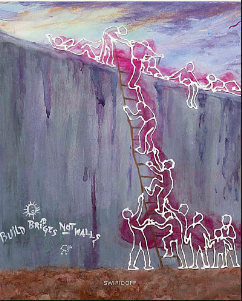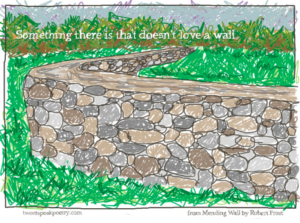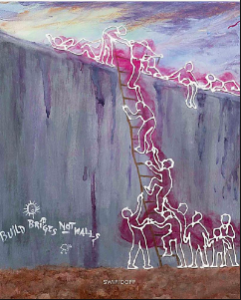Walls — Sometimes, Believe it or Not, — a Poem Helps

There is a wonderful half hour series on some PBS stations (and probably podcasts, too) called Poetry in America. It highlights how poets and poems have informed, enlightened and inspired our thinking on all kinds of issues. Check out, as an example, the one focusing on Gwendolyn Brooks’ poem, “To Prisoners”.
Because I have been thinking, as probably you are, too, about the immigrants featured so prominently in the news today, I have also been forced to think about walls, and why those in power so often want to construct them, and those with privilege, earned or not, want to preserve them.
 Our focus here, however, is the church and feminism and ordination – which brings us to other walls we know so well: those constantly patched, preserved, and perpetuated by hierarchical trowels full of fear and mortars full of hostility. What do we do about them? Is there a way to prevent them, to remedy their harm? In the spirit of Poetry in America, I turned to Robert Frost for some perspective.
Our focus here, however, is the church and feminism and ordination – which brings us to other walls we know so well: those constantly patched, preserved, and perpetuated by hierarchical trowels full of fear and mortars full of hostility. What do we do about them? Is there a way to prevent them, to remedy their harm? In the spirit of Poetry in America, I turned to Robert Frost for some perspective.
His poem, “Mending Wall” begins: “Something there is that doesn’t love a wall.” Something, in fact, “sends the frozen-ground-swell under it…And makes gaps even two can pass abreast.” That “something” breaks the wall and turns its fallen boulders into “loaves” or “balls” on the ground, things that nurture or give pleasure, and trying to use them to rebuild the wall “will only wear our fingers rough with handling them.”
Broken wall fragments used to nurture and renew: isn’t that what we are all about as we campaign for women’s leadership and ministry? Broken wall fragments used to rebuild barriers again: isn’t that what wears down fingers – and hearts? I love also that the cracks in the wall allow enough space for two to walk side by side, one with another partner in this mission, or one in favor and one against – talking perhaps?
The poet goes on to ruminate about his neighbor on the other side of the wall: “He is all pine and I am apple orchard./My apple trees will never get across/And eat the cones under his pines, I tell him.,” The neighbor has a famous retort: “Good fences make good neighbors.” The poet, however, ponders that reply, “Why do they make good neighbors?…Before I built a wall I’d ask to know/What I was walling in or walling out,/And to whom I was like to give offense./Something there is that doesn’t love a wall.”

George Finley
Can we convince the wall builders that we, the “apple trees,” strong, brave Eves, will not eat up their manly “pine cones” with our female bodies, spirits, and gifts? Can we convince them that walls will not really preserve their neighborliness or more significantly neighborhood? While they are walling out community and possibility and grace, do they think of the paralyzing isolation, loneliness, and decay they are walling in?
Fear and hostility, however, are strong opponents, and they gain their strength from very dark impulses. Frost describes his neighbor as he works to rebuild the wall: “I see him there,/Bringing a stone grasped firmly by the top/In each hand, like an old-stone savage armed.” He goes on more chillingly, “He moves in darkness as it seems to me,/Not of woods only and the shade of trees.”
Of course, we wall removers don’t want to move into that kind of deep, sad, darkness either as we build our own walls to close those other builders and maintainers out. We may be frustrated, angry, and fed up, but we are not “stone savage armed” people; we do not want to fortify our own walls. We are just not that kind of neighbor. Are we?

2 Responses
Finding cracks in the wall is very helpful in the process of tearing it down. Ecclesiastical patriarchy is the wall. We must analyze the wall carefully in order to find the cracks. I suggest we can start with the cracks in CCC 1577 and 1598. St JP2’s Theology of the Body is the bridge, and the best hammer to tear the wall down, in perfect continuity with apostolic tradition.
Thanks, as always, Ellie for this astute analysis. You bring a whole new meaning to a poem that might possibly be the most misunderstood poem in the country (‘good fences make good neighbors’ often being used in the opposite intention of the poem, as you demonstrate.)